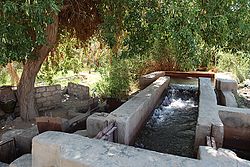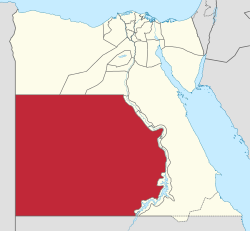New Valley Governorate | |
|---|---|
 | |
 New Valley Governorate on the map of Egypt | |
| Coordinates: 24°32′44″N 27°10′24″E / 24.54556°N 27.17333°E | |
| Country | |
| Seat | Kharga |
| Government | |
| • Governor | Mohammed Salman Mousa Al-Zamlout[1] |
| Area | |
• Total | 440,098 km2 (169,923 sq mi) |
| Population (January 2024)[2] | |
• Total | 270,854 |
| • Density | 0.60/km2 (1.6/sq mi) |
| GDP | |
| • Total | EGP 17 billion (US$ 1.1 billion) |
| Time zone | UTC+2 (EET) |
| ISO 3166 code | EG-WAD |
| HDI (2021) | 0.738[4] high · 10th |
| Website | www |

New Valley Governorate is an enormous governorate in Egypt. It is also called El Wadi El Gedid Governorate (Arabic: محافظة الوادي الجديد [moˈħɑfzet elˈwæːdi lɡɪˈdiːd], Muḥāfaẓah al Wādī al Jadīd). It is in the southwestern part of the country, in the south of Egypt Western Desert (part of the Sahara Desert), between the Nile, northern Sudan, and southeastern Libya.
Consisting of roughly half of Egypt's area, this governorate is the country's largest and most sparsely populated, and one of the largest country subdivisions in the world. The capital is Kharga. New Valley Governorate is named after the New Valley Project, which aims to irrigate parts of the Western Desert.
Municipal divisions
[edit]The governorate is divided into municipal divisions with a total estimated population, as of January 2024, at 270,854. In the case of New Valley governorate, there is one kism with urban and rural parts, and four marakiz.[2]
| Anglicized name | Native name | Arabic transliteration | Population (January 2023 Est.) |
Type |
|---|---|---|---|---|
| Kharga | قسم الواحات الخارجة | Al-Wāḥāt al-Khārijah | 104,683 | Kism (urban and rural parts) |
| Balat | مركز بلاط | Balāṭ | 13,025 | Markaz |
| Dakhla | مركز الداخلة | Al-Dākhlah | 95,019 | Markaz |
| Farafra | مركز الفرافرة | Al-Farāfirah | 37,509 | Markaz |
| Baris | مركز باريس | Bārīs | 14,767 | Markaz |
In an effort to decentralize the administration of Kharga, it was divided into four sections effective 19 June, 2018.[5]
Population
[edit]According to population estimates, in 2015 the majority of residents in the governorate lived in rural areas, with an urbanization rate of only 48.0%. Out of an estimated 225,416 people residing in the governorate, 117,180 people lived in rural areas and only 108,236 lived in urban areas.[6][7] In 2018 the population was 245,000, with an urbanization rate of 46.7%.[8]
Cities, towns, oases
[edit]New Valley has a number of cities, towns and oases. As of 2018, Kharga Oasis, and Dakhla Oasis were the two places in New Valley with a population of over 15,000. Farafra Oasis and Baris Oasis are also in New Valley.[9]
| Anglicized name | Native name | Arabic transliteration | Nov. 1996 Census | Nov. 2006 Census | Population (July 2017 Est.) |
|---|---|---|---|---|---|
| Kharga Oasis | الخارجة | Al-Khārijah | 49,446 | 60,584 | 72,558 |
| Dakhla | الداخلة | Mūṭ (Ad-Dākhlah) | 16,252 | 20,439 | 23,415 |
Industrial zones
[edit]According to the Egyptian Governing Authority for Investment and Free Zones (GAFI), in affiliation with the Ministry of Investment (MOI), the following industrial zones are located in this governorate:[10]
- Al Kharga
- Heavy industrial zone - El Dakhla
- Heavy industrial zone - Wadi Waer West
New Valley also contains some farming areas created by the New Valley project, like Sharq El Owainat.

History
[edit]2011 Egyptian revolution
[edit]Violent clashes were reported in the New Valley Governorate on February 8–9, 2011 as part of the 2011 Egyptian revolution. Protesters set fire to police stations and the National Democratic Party building. Multiple deaths were reported in addition to hundreds of injuries amid claims that the police opened fire on protesters in Kharga Oasis with live ammunition.[11][12]
2014 Farafra ambush
[edit]On 19 July 2014, unidentified gunmen ambushed a desert checkpoint by the Farafra Oasis Road in New Valley Governorate. Twenty-two border guards were killed in the attack, which was one of the biggest since the July 2013 ousting of Egyptian president Mohamed Morsi and the second at the same checkpoint in less than three months.
Industry
[edit]- Farming of dates
- Tourism and safaris
- Agricultural activities (around oases)
See also
[edit]References
[edit]- ^ "رسمياً.. المحافظون الجدد ونوابهم يؤدون اليمين الدستورية أمام الرئيس" [Officially... the new governors and their deputies take the constitutional oath before the president]. Almasry Alyoum (in Arabic). 30 August 2018. Archived from the original on 31 August 2018. Retrieved 31 August 2018.
- ^ a b "ﻋـــﺩﺩ ﺍﻟﺳﻛــﺎﻥ ﺍﻟﺗﻘﺩﻳﺭﻯ ﻟﻸﻗﺳــﺎﻡ" [Estimated population number of sections] (PDF). www.capmas.gov.eg (in Arabic). Retrieved 3 April 2023.
- ^ "GDP BY GOVERNORATE". mped.gov.eg.
- ^ "Sub-national HDI - Subnational HDI - Table - Global Data Lab". globaldatalab.org. Retrieved 20 February 2023.
- ^ "تقسيم مدينة الخارجة إلى 4 أحياء وتعيين رؤساء لها" [Divide the city of Kharja into 4 districts and appoint its chiefs]. El Watane News (in Arabic). 19 June 2018. Archived from the original on 25 November 2018. Retrieved 24 November 2018.
- ^ "Population Estimates By Sex & Governorate 1/1/2015" (PDF). CAPMAS. Archived (PDF) from the original on 19 October 2015. Retrieved 23 October 2016.
- ^ "Population Estimates By Sex & Governorate 1/1/2015" (PDF). CAPMAS. Archived (PDF) from the original on 19 October 2015. Retrieved 17 October 2016.
- ^ "Egypt in Figures 2018". Archived from the original on 2 November 2018.
- ^ "Cities". CityPopulation.de. Archived from the original on 5 October 2018. Retrieved 24 November 2018.
- ^ "Industrial Zones of Governorate". Ministry of Investment Egypt. Archived from the original on 23 November 2018. Retrieved 23 November 2018.
- ^ "Live blog Feb 9 - Egypt protests". Al Jazeera. Archived from the original on 23 July 2011. Retrieved 9 February 2011.
- ^ Fahim, Kareem; Kirkpatrick, David D. (9 February 2011). "Labor Actions in Egypt Boost Protests". The New York Times. ISSN 0362-4331. Retrieved 12 May 2023.

